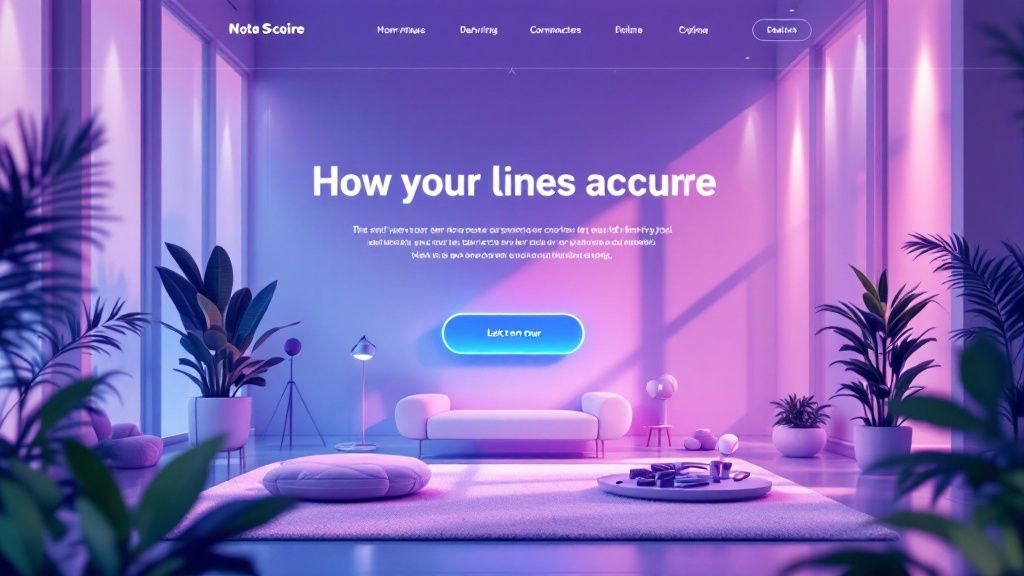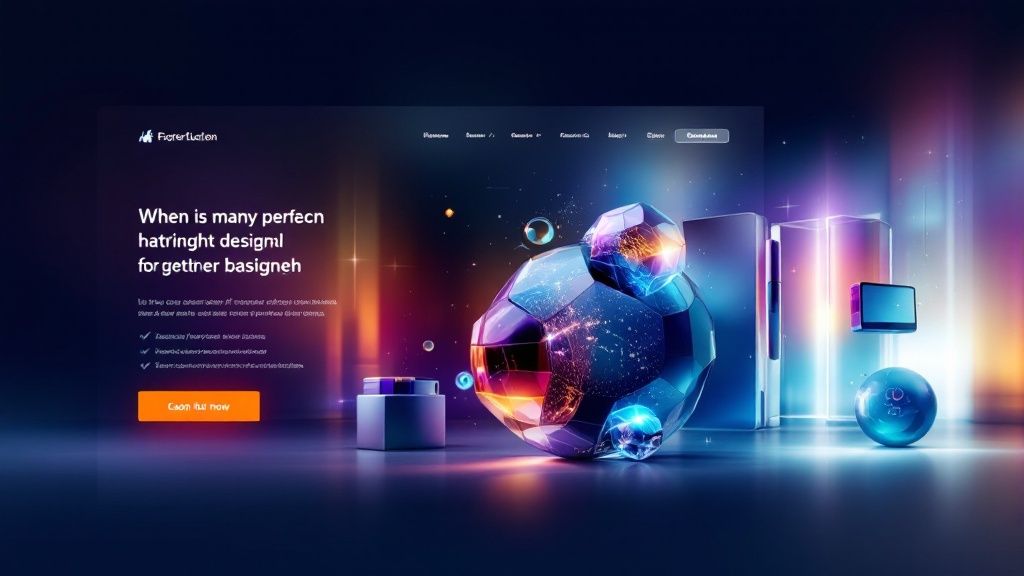How to Increase Website Conversion Rate: Your Data-Driven Guide to Higher Performance
Mastering Website Speed for Breakthrough Conversion Rates

Your website’s speed can make or break your online success. When customers visit your site, every second counts. A slow-loading page often leads to abandoned shopping carts and lost sales. Let’s explore how speed affects conversions and what you can do to improve it.
The numbers tell a clear story - faster websites convert better. Research shows that a 1-second load time can triple your conversion rate compared to a 5-second load time. Even more striking, sites loading in one second see 5x higher conversion rates than those taking 10 seconds. For more details, check out these conversion rate statistics from WordStream.
Identifying Performance Bottlenecks
Before making improvements, you need to find what’s slowing down your site. Common issues include:
- Large Image Files: High-resolution images without proper optimization
- Too Many HTTP Requests: Each page element needs its own server request
- Bulky Code: Unnecessary code that makes files bigger than needed
- Slow Server Response: Problems with your hosting provider’s speed
Implementing Advanced Caching Strategies
Caching saves frequently used data for quick access later. This simple concept can dramatically speed up your site through:
- Browser Caching: Store static files on visitors’ devices
- Server-Side Caching: Keep database content ready for quick delivery
- Content Delivery Network (CDN): Spread your content across servers worldwide
Optimizing Site Architecture for Speed
Smart site structure helps pages load faster. Focus on these key areas:
- Code Clean-Up: Combine and minimize CSS and JavaScript files
- Image Fixes: Compress images and use the right file types
- Smart Loading: Load images only when visitors scroll to them
A faster website means happy customers who stay longer and buy more. By fixing these speed issues, you’ll create a better experience that turns more visitors into buyers.
Crafting Personalization Strategies That Transform Visitor Behavior

Website personalization goes beyond just using a visitor’s name. At its core, it’s about understanding what each person needs and making their experience match those needs. When you create experiences that feel personal and relevant, people engage more and are more likely to take action.
Understanding the Power of Personalization
Think about shopping at a store where the staff knows exactly what you like. They show you items that match your style and preferences, making shopping easy and enjoyable. This same concept works online - instead of showing everyone the same content, you can present each visitor with items and information that match their interests.
The numbers show why this matters: websites with personalized experiences see an average conversion rate of 19%, while those without personalization only convert at 2.9%. Learn more about these statistics here. This significant difference shows how much personalization can boost your results.
Implementing Effective Personalization Tactics
Here are practical ways to add personalization to your website:
- Segment Your Audience: Group visitors based on factors like location, behavior, or past purchases so you can show them relevant content
- Dynamic Content: Show different content to different groups based on what you know about them, from product suggestions to special offers
- Personalized User Paths: Create different website experiences based on whether someone is visiting for the first time or returning
Scaling Your Personalization Efforts
Start small with basic personalization like custom email greetings, then build up to more complex features as you learn what works. Test each change to make sure it improves results. As your skills grow, you might want to try tools that use AI to automate personalization. By making each visitor’s experience feel personal and relevant, you can turn more browsers into buyers.
Content Optimization Strategies That Drive Action
Getting content that truly delivers means going beyond just good writing. Your content should lead readers smoothly toward taking action. By studying what works on successful websites, we can transform regular content into something that motivates people to convert.
Making Content Easy to Read and Engaging
Clear, readable content is essential. Think of your content like a well-organized store where everything is easy to find. When readers can quickly understand your message, they’re more likely to take action. Here’s what helps:
- Short Paragraphs: Keep text blocks small and digestible
- Clear Headers: Help readers navigate with descriptive section headings
- Bullet Points: Present key information in scannable lists
- Visual Elements: Add relevant images and videos to break up text
This approach keeps readers engaged longer, helping them absorb your message and move toward conversion.
Using Psychology in Your Calls-to-Action
The most effective calls-to-action (CTAs) tap into basic human psychology. Try these proven approaches:
- Build Urgency: Use phrases like “Limited-Time Offer” to encourage quick decisions
- Show Limited Availability: Let people know when supplies or spots are running low
- Use Action Words: Be direct with verbs like “Download,” “Register,” or “Shop Now”
These techniques give readers clear reasons to act immediately rather than delay.
Creating Value Propositions That Work
Your value proposition explains why someone should choose you. Make sure yours is:
- Simple: Easy to understand in seconds
- Focused on Benefits: Highlight what customers gain
- Distinctive: Show what makes you different
A strong value proposition connects with your audience and makes your offering’s benefits crystal clear. For even better results, look at improving your existing content, especially older blog posts. Study your analytics to find opportunities for improvement. Learn more about getting better results from your old blog content here. When you put these optimization methods into practice, you’ll see more visitors becoming customers.
Data-Driven A/B Testing for Continuous Improvement

Making improvements to your website shouldn’t be based on guesswork. A/B testing helps you make smart decisions using real data about how visitors interact with your site. By testing different versions of your pages, you can see what actually works to increase conversions.
Creating and Prioritizing Test Ideas
Start each test with a clear hypothesis - identify something specific you want to change and predict how it will affect conversions. For example, you might think that changing your “Add to Cart” button color will get more clicks. Make a list of test ideas and prioritize them based on:
- Potential impact on conversions
- How easy they are to implement
- Available time and resources
Running Clean Tests
When running A/B tests, change just one element at a time. If you’re testing a button color, don’t also change the text - this makes it impossible to know which change made the difference. Give your tests enough time to gather meaningful data. Quick tests often lead to wrong conclusions due to random variations in user behavior.
Learning from Results
After each test, examine the data carefully. Did the changes increase or decrease conversions? Use these insights to guide your next steps. If something works well, roll it out across your site. If a test fails, that’s still valuable information - analyze why it didn’t work and try a different approach. Through ongoing testing and refinement, you’ll steadily improve your site’s performance and conversion rates over time.
Building Frictionless User Experiences That Convert

A website that drives sales needs to feel smooth and natural to use. Think of your favorite local store - you keep going back because everything is easy to find and buying is hassle-free. Your website should create that same feeling. Let’s explore how to build a user experience that naturally guides visitors toward conversion.
Intuitive Navigation: Making Things Easy to Find
Nobody likes feeling lost. Your website’s navigation should be as clear as the signs in a well-organized store. When visitors can easily find what they want, they’re more likely to stick around and take action.
Key elements of clear navigation include:
- Simple Menu Structure: Group related items together in ways that match how customers think
- Clear Labels: Use straightforward terms that visitors understand, not internal jargon
- Smart Search: Add a prominent search bar with helpful features like autocomplete to help visitors quickly find what they need
Forms That Don’t Frustrate
Forms are often the last step before a conversion happens. A clunky form can chase away even highly interested visitors. Keep forms simple and straightforward:
- Ask Only What’s Needed: Every extra field makes visitors more likely to give up
- Give Clear Direction: Include simple instructions to prevent confusion and mistakes
- Make Mobile Work: Test forms thoroughly on phones since many people convert on mobile
Building Trust Through Proof
People need to feel confident before they’ll take action on your site. Show them they can trust you:
- Security Badges: Display recognized security certificates to demonstrate your site is safe
- Real Reviews: Share authentic customer feedback to prove your value
- Easy Contact: Make it simple for visitors to reach you with questions
Adding these trust elements makes a real difference - showing customer reviews can boost conversions by over 120%. This shows how much trust matters in the buying process.
Regular UX Check-Ups
Think of UX audits like regular health check-ups for your website. By reviewing how visitors use your site, you can spot and fix problems before they hurt your conversion rates. Look at visitor behavior, test key pathways, and make targeted improvements based on real data. This helps ensure your site stays effective at turning visitors into customers.
Advanced Analytics and Performance Measurement
Want to know if your website changes are delivering real results? Advanced analytics and performance tracking provides clear insights into user behavior and its impact on your conversion rate. Going beyond basic visitor counts, it helps you understand the “why” behind user actions.
Setting Up Comprehensive Tracking
Just like you need a map to navigate a new city, you need proper tracking to improve your website conversions. A good tracking system shows the complete user journey from first click through final purchase. Key elements include:
- Analytics goals and conversion tracking: Define key actions you want users to take, like completing purchases, newsletter signups, or resource downloads
- Event tracking: Monitor specific interactions like button clicks, video views, and form submissions to understand engagement
- Custom metrics: Track data points specific to your business needs, such as membership types or referral sources
Understanding User Behavior
Raw data only becomes valuable when you analyze it properly. Modern analytics tools help you spot important behavior patterns and areas for improvement:
- User flow analysis: See how visitors move through your site, where they leave, and what stops them from converting
- Audience segmentation: Group users by traits like demographics or purchase history to understand different needs and personalize experiences
- Cohort tracking: Follow groups of users over time to spot patterns in how they convert and what makes them come back
Creating Custom Dashboards
A well-designed dashboard gives you quick access to your most important conversion data. Include key metrics like:
- Conversion rates by traffic source: Know which channels bring your best visitors
- Average order value: Track typical purchase amounts
- Customer lifetime value: See the total value each customer brings over time
Having these numbers easily visible helps you make better decisions based on real data rather than guesses.
Pick analytics tools that match your specific needs and budget. Once you master these techniques, you can turn your data into clear actions that boost your conversion rates and grow your business.
Need help turning your website into a conversion powerhouse? GWC helps small businesses and individuals succeed online through proven SEO, social media, and web design strategies. We build user-friendly sites that drive real results. Learn more at GWC.